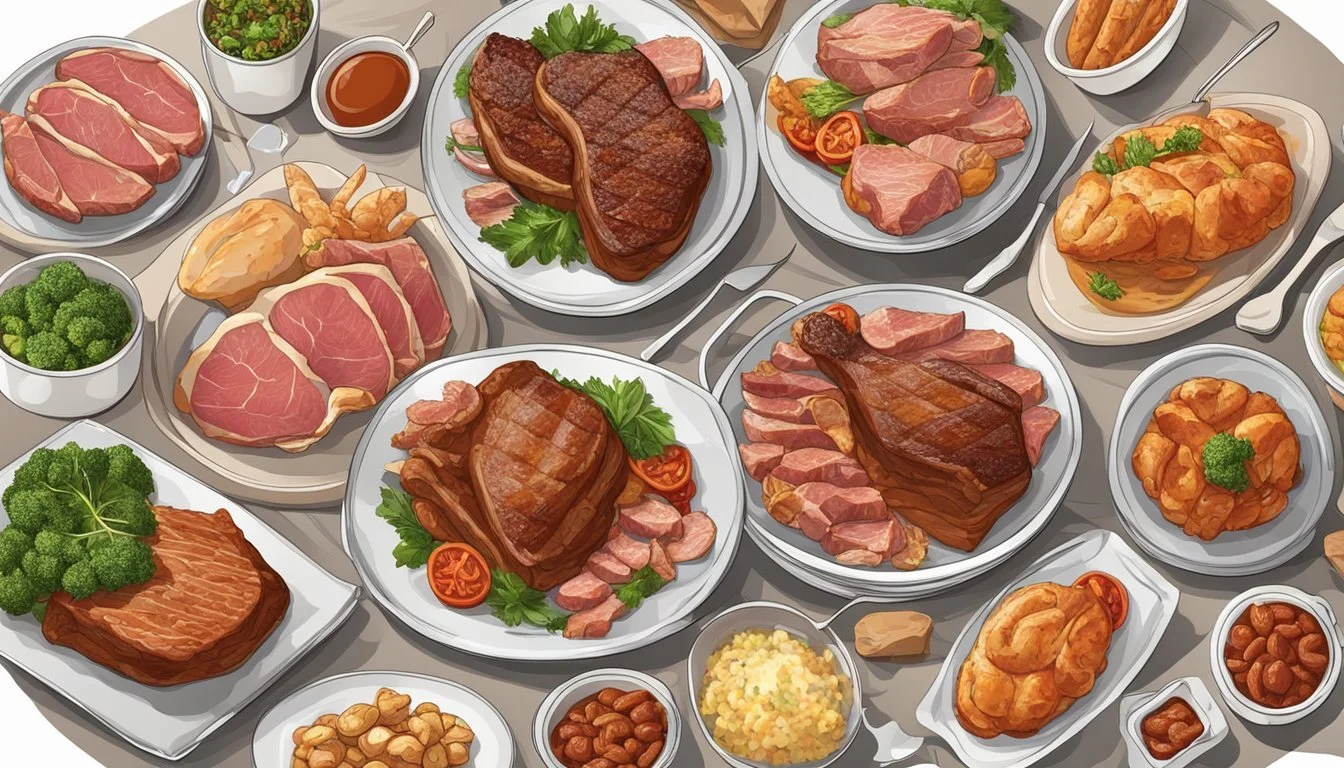How to Understand the Role of Fat in a Carnivore Diet
A Nutritional Guide
Understanding the role of fat within a carnivore diet is crucial for individuals looking to harness the health and nutrition benefits of this eating pattern. Commonly characterized by the consumption of animal products exclusively, the carnivore diet emphasizes meat as a staple source of nutrients. Fat, in this context, is not just a calorie-dense macronutrient; it serves as a primary energy source and is essential for various bodily functions, including hormone production and the absorption of fat-soluble vitamins.
The consumption of fat in a carnivore diet aids in weight management by promoting satiety, which can help regulate appetite and reduce overeating. Contrary to the common misconception that eating fat leads to weight gain, incorporating high-quality fat sources can aid in weight loss or maintenance due to its role in ketosis. This metabolic state occurs when the body burns fat for fuel in the absence of carbohydrates, providing sustained energy levels and supporting overall health.
When adopting a carnivore diet, it is important to seek balance in fat and protein intake while listening to the body's cues. This balance is key in achieving long-term success and optimizing energy levels through diet. As individuals embark on their carnivore diet journey, understanding and integrating the proper role of fat becomes a pivotal aspect of nutrition and health.
Understanding the Carnivore Diet
The Carnivore Diet prioritizes animal products and excludes plant-based foods, focusing on high protein and fat intake with nearly zero carbohydrates.
Defining a Meat-Only Diet
A meat-only diet, commonly referred to as the Carnivore Diet, consists exclusively of animal products like meat, fish, eggs, and dairy. Its defining characteristic is the elimination of plant-based foods, positioning it as an extreme form of low-carb, high-fat, and high-protein diet. This diet is often considered a zero-carb diet, though this isn't entirely accurate since some animal products contain small amounts of carbohydrates.
Key Components of a Meat-Only Diet:
Primary Focus on Red Meat: Beef, lamb, and pork are staples.
Inclusion of Other Animal Products: Eggs, poultry, fish, and certain dairy products complement the diet.
Exclusion of Carbohydrates: Virtually no fruits, vegetables, grains, or sugars are consumed.
Fat as a Key Energy Source: High intake of animal fats is encouraged for energy and satiety.
Historical Insights of Carnivorous Eating Patterns
Historically, many cultures have thrived on predominantly carnivorous eating patterns, especially those in arctic regions where plant foods were scarce. They relied on animal products not only for protein but also for essential fats. These historical diets often included a variety of meats and organ consumption to obtain a complete nutrient profile. It's important to note that these populations had consumption patterns aligned with their environment and availability of resources.
Notable Historical Carnivore Diets:
The Inuit: A population that consumed a diet high in whale, seal, and fish.
Nomadic Tribes: Such as the Mongols and the Masai, who ate mostly livestock meat, milk, and blood.
While the modern Carnivore Diet is inspired by such patterns, it adapts to today's food environment and availability. The diet draws on the hypothesis that humans can maintain optimal health by consuming primarily meat, just as some ancestors historically did.
Role of Fat in Energy Metabolism
In a carnivore diet, fat is not just a nutrient; it serves as the cornerstone of energy metabolism. It is critical for sustaining the body's energy needs, especially when dietary carbohydrates are scarce.
Fat as a Primary Energy Source
Fat acts as a dense energy source, providing approximately 9 calories per gram - more than twice the energy yield of carbohydrates or proteins. This high caloric density means that fats are an efficient fuel for the body's metabolic activities. On a carnivore diet, where carbohydrate intake is minimal, dietary fat becomes the main substrate for energy production. The body stores excess fat in adipose tissue, a readily available energy reserve during periods of fasting or when food is scarce.
Ketosis and Fat Metabolism
When following a carnivore diet, the body often enters a metabolic state known as ketosis. During ketosis, the liver converts fats into ketone bodies—alternative energy molecules that the body uses in place of glucose. This process ensures a sustainable energy supply that can support normal physiological functions, even in the absence of dietary carbohydrates. Moreover, ketosis is associated with several health benefits, including improved weight management and potentially enhanced mental clarity.
By relying on fat for fuel, the body is able to maintain energy balance and support metabolic health in the context of a carnivore dietary pattern.
Health Benefits of Dietary Fat
Dietary fats play an indispensable role in a carnivore diet, contributing to nutritional balance, muscle functioning, and hormonal well-being.
Nutritional Advantages
Fats are a dense source of energy, crucial for individuals on a carnivore diet. They provide sustainment, especially when carbohydrate intake is remarkably low. Omega-3 and omega-6 fatty acids, which the body cannot produce on its own, are essential for maintaining health and must be obtained from the diet. These fatty acids aid in the absorption of fat-soluble vitamins—A, D, E, and K—which are pivotal for numerous bodily functions.
Effects on Muscle Mass and Performance
In the context of muscle health and performance, fats are significant. They serve as an energy reserve, allowing muscle retention and growth, particularly when combined with adequate protein intake. A carnivore diet with balanced fat consumption can support weight loss while preserving muscle mass, as the body taps into fat reserves for energy in the absence of carbohydrates.
Influence on Hormones and Brain Health
Fats have a profound influence on hormone production and brain health. Cholesterol, found in animal fats, is a building block for steroid hormones such as testosterone, which is vital for muscle development and overall vitality. Additionally, dietary fats regulate the production of cortisol, the stress hormone. The balance of fatty acids is essential for cognitive functions and maintaining focus, as the brain consists largely of fat.
Types of Fats Consumed on a Carnivore Diet
The carnivore diet focuses on animal products, and understanding the types of fat consumed is crucial for nutritional balance. Fats are a major energy source on this diet and can influence overall health.
Saturated Fats and Cholesterol
On a carnivore diet, individuals primarily consume saturated fats and cholesterol. Saturated fats are found extensively in beef, pork, and other ruminant meats. For instance, a 100-gram serving of ribeye steak provides about 22 grams of fat, which is largely saturated. Cholesterol, present in all animal tissues, is also consumed in significant amounts.
Sources: Ruminant Meat vs. Seafood and Eggs
The primary sources of fat in the carnivore diet come from ruminant meat like beef, which offers a rich supply of both saturated fats and cholesterol. In contrast, seafood and eggs provide a wider array of fats, including essential fatty acids. Fish, in particular, is known for contributing omega-3 fatty acids, which are less predominant in ruminant meat.
Importance of Omega-3 Fatty Acids
Omega-3 fatty acids are crucial for maintaining heart health and reducing inflammation. They can be sourced from fish and eggs within the carnivore diet. Incorporating seafood such as salmon will ensure a good intake of these fatty acids. It's important to aim for a balance, as a variety of fat sources supports overall health.
Common Sources of Fat for Carnivores
Within a carnivore diet, sourcing adequate fat is crucial for energy and overall health. Fat-rich foods not only serve as a primary energy source but also assist in nutrient absorption and hormone regulation.
Dairy Products and Butter
Dairy products, such as cheese and full-fat yogurt, are convenient sources of fat for those who include dairy in their carnivore diet. Butter, especially from grass-fed cows, is another cornerstone of fat intake due to its high saturated fat content, which is beneficial for cooking and adding flavor to various cuts of meat.
Selecting Fatty Cuts of Meat
The selection of fatty cuts of meat is integral to ensuring sufficient fat intake on a carnivore diet. For example, cuts like ribeye steak predominantly provide calories from fat. Meat from beef, pork, and lamb with visible marbling--the white flecks of fat within the meat--tends to be higher in fat content, providing both flavor and energy.
Inclusion of Organ Meats
Organ meats, such as liver, are often overlooked but they are nutrient-dense and contain essential fats. They offer a variety of fats including omega-3 fatty acids, which are crucial for cardiovascular health. Adding organ meats to the diet can be beneficial for both their fat content and their richness in other nutrients.
Balancing Macronutrients
Balancing macros on a carnivore diet is critical for optimizing body composition and health goals. Ensuring the right mix of protein and fats directly influences muscle mass, weight loss, and overall protein intake.
Protein to Fat Ratio
The carnivore diet emphasizes a high intake of animal products, so managing the protein to fat ratio is a key consideration. An often recommended ratio by calories is roughly 2:1 to 3:1 of fat to protein. This means for every gram of protein, one should consume between two to three calories from fat. It translates to 1.5:1 grams of fat for every gram of protein for maintaining a state of ketosis and energy balance.
Adjusting for Weight Loss and Muscle Gain Goals
For weight loss, a caloric deficit is needed. Reducing dietary fat while maintaining adequate protein helps preserve muscle mass during this process. One might aim for a protein intake of 1.2 to 1.5 grams per pound of lean body mass, which can support satiety and muscle maintenance.
Conversely, increasing muscle mass requires a caloric surplus with higher protein intake and adequate fat for energy. Aim for 1 gram to 1.2 grams of protein per pound of lean body mass, and adjust fat intake to create the necessary surplus for weight gain.
Potential Drawbacks and Considerations
When adopting a carnivore diet, individuals must consider the possible negative impacts, particularly regarding fat intake. These include increased risk of inflammation, potential long-term health consequences, and the need for professional guidance.
Inflammation and Autoimmune Conditions
A diet high in animal fats can lead to elevated levels of inflammation in some individuals, potentially aggravating autoimmune conditions. It is crucial to monitor inflammatory markers and symptoms to ensure that the diet does not exacerbate any pre-existing conditions.
Long-Term Health Implications
The carnivore diet, being restrictive in nature, may lead to nutrient deficiencies and an imbalance of fatty acids, impacting overall health. Long-term adherence to such a diet should be carefully evaluated for its effects on vital health parameters including blood pressure and cholesterol levels.
Consulting Healthcare Professionals
Before beginning a carnivore diet, individuals should consult with healthcare professionals. They can provide personalized advice and monitor potential health risks, including the management of any underlying health conditions that may be affected by a shift in dietary fat intake.
Culinary Practices and Meal Planning
In a carnivore diet, culinary practices center around the thoughtful selection of nutrient-rich animal products and strategic meal planning to ensure both variety and satisfaction.
Creating Diverse Meal Options
The inclusion of various cuts of meat is foundational to a carnivore diet. For instance, one might choose rib eye steak for its marbling and fattiness, while leaner cuts such as chicken breast supply protein with less fat. Seafood, a source of essential omega-3 fatty acids and various vitamins and minerals, also contributes to meal diversity.
Examples of Diverse Meal Options:
Breakfast: Scrambled eggs with smoked salmon
Lunch: Grilled chicken breast with a side of bone marrow
Dinner: Pan-seared rib eye steak
Cheese and Eggs for Variety
Cheese and eggs serve as a versatile component within the carnivore diet, enhancing meals with additional fat, flavor, and texture. Cheese is high in calcium and protein and can be incorporated into meals or consumed as a snack. Eggs are a complete protein source, rich in vitamins D and B12, and can be prepared in various ways to suit different meals.
Meal Enhancements with Cheese and Eggs:
Breakfast: Omelette with cheddar cheese
Snack: Boiled eggs or slices of gouda cheese
Dinner: Cheeseburger patties served without a bun
Incorporating Bone Broth
Bone broth is a nutritious addition to the carnivore diet, providing a source of minerals such as calcium, magnesium, and potassium. It can be consumed alone or used as a base for sauces and gravies to accompany other meats. The gelatin in bone broth also helps with digestion and joint health.
Ways to Use Bone Broth:
Sipping Alone: Warm bone broth seasoned with herbs
Cooking: Using bone broth to prepare chicken or seafood
Sauces: Creating gravies for steaks or roasts
Transitioning and Adapting to a Carnivore Diet
Individuals may face initial digestive and energy fluctuations as they adapt to using fat for fuel in a carnivore diet, which can have profound impacts on performance and long-term health goals.
Initial Challenges and Adapting to Fat as Fuel
Transitioning to a carnivore diet often involves a significant shift in macronutrient intake, moving away from carbohydrates and towards fat as the primary source of energy. This shift can lead to adaptation symptoms as the body learns to utilize fat more efficiently.
Energy Shifts: Initially, individuals may experience low energy as their bodies deplete glycogen reserves and begin to convert to a fat-burning state.
Digestive Changes: The increase in dietary fat may result in digestive discomfort while the gut microbiome adapts.
Adapting to a fat-based energy system can be facilitated by:
Gradually Increasing Fat Intake: To mitigate digestive distress, one should gradually increase their intake of fats from sources such as beef, eggs, and dairy.
Electrolyte Management: Adequate electrolytes support the transition to ketogenesis, an important process where the body produces ketones for energy in the absence of glucose.
Maintaining a Carnivore Diet Long-Term
After the initial adaptation phase, maintaining a carnivore diet requires a focus on:
Sustainable Fat Sources: Ensuring a consistent intake of high-quality animal fats supports long-term adherence and energy levels.
Nutrient Density: Prioritizing foods like organ meats helps cover nutritional needs without plant-based foods.
Overall, individuals should monitor their body's responses and tailor their diet to support their energy needs and performance goals, keeping in mind that each person's experience with the ketogenic aspect of the carnivore diet can vary widely.
Navigating Social and Cultural Aspects
Adopting a carnivore diet often requires an individual to navigate a landscape that includes social gatherings and the prevailing discussions in nutritional science. Understanding and addressing dietary restrictions in social settings and situating the carnivore diet within contemporary nutrition debates are pivotal.
Handling Dietary Restrictions in Social Settings
When one follows a carnivore diet, social events can pose challenges, as the available food options often extend beyond animal products. Attendees should communicate their dietary preferences ahead of time to hosts to ensure an accommodation can be made. It can be helpful to:
Bring one's own meal to gatherings, which guarantees compliance with dietary restrictions.
Offer to share a carnivore-friendly dish with others, which also introduces them to the diet.
Maintaining respect for others' dietary choices while asserting one's own can lead to a more inclusive social experience.
Carnivore Diet in the Context of Modern Nutrition Debates
The carnivore diet generates discussion within the broader context of modern nutrition debates, where its health benefits and effectiveness are scrutinized. Advocates argue for its simplicity and potential benefits which include weight loss and improved metabolic markers. Critics, on the other hand, express concerns about long-term sustainability and potential nutrient deficiencies. It is important that individuals:
Review peer-reviewed research and credible sources to inform their discussions.
Engage in evidence-based dialogue while acknowledging ongoing scientific investigation into the nutritional merits of the carnivore diet.
As nutritional science evolves, so do the conversations about diet and health, including the role of a carnivore diet in achieving health goals.
Supplementation and Nutrient Density
In a carnivore diet, vital nutrients must be procured exclusively from animal sources. It is crucial to understand the density of nutrients within these foods and address any potential gaps through targeted supplementation.
Addressing Potential Nutrient Gaps
The carnivore diet typically offers high levels of fat-soluble vitamins and minerals from animal products. However, individuals may experience a deficiency in certain nutrients that are less abundant in meat. For example, Vitamin C and some minerals are found in higher concentrations in plant-based foods. As the diet excludes these foods, one should be vigilant about their nutrient intake to prevent deficiencies.
Supplementation: Vitamins and Minerals
Should a deficiency be identified, supplementation could be considered. Here are some essential nutrients that might require attention:
Vitamins:
Vitamin C: While fresh meat contains some Vitamin C, it might be insufficient. A low-dose supplement can be beneficial.
Minerals:
Magnesium: Often lower in animal-based foods. A quality magnesium supplement can aid in maintaining adequate levels.
For most individuals on a carnivore diet, eating a variety of animal products—including organ meats, which are rich in vitamins like Vitamin A, Vitamin D, and a range of B vitamins—can often provide the necessary spectrum of nutrients without the need for additional supplements. Nonetheless, tailoring supplementation to individual needs is recommended to ensure all nutrient requirements are met.
I highly recommend purchasing vitamin C and magnesium supplement online for a convenient shopping experience!
Frequently Asked Questions
In this section, various concerns regarding fat in a carnivore diet are addressed, including common misconceptions, insights from experts, and resources for further education to ensure readers are well-informed.
Addressing Common Misconceptions
One prevalent misconception is that high fat intake negatively affects the gut microbiome; however, a carnivore diet typically involves the consumption of natural fats found in meat, which can be different from processed or trans fats found in other diets. Enzymes specific to fat digestion are adapted to process these types of fats. Hormonal balance can also be affected by dietary fats, but natural saturated fats from animal sources may play a role in hormonal healing and regulation in the context of a carnivore diet.
Fullness is another aspect where fats play a crucial role, helping to promote satiety and thereby potentially aiding in weight management. The carnivore diet emphasizes the importance of consuming enough fats to maintain proper metabolism, reflecting the need for a balanced macronutrient profile where fats provide a sufficient amount of calories.
Expert Insights
Experts in nutritional science suggest that while the carnivore diet significantly reduces the variety of consumed macros, it emphasizes the inclusion of fats for their benefits, which can impact mood and energy levels. They note that because the diet consists solely of animal products, it's imperative to eat a variety of meats, including fatty cuts, to obtain a complete nutrient profile. Experts also point out that enzymes involved in fat digestion become more efficient on a carnivore diet, supporting the body's metabolic processes.
Reference Guides and Further Reading
For those seeking to deepen their understanding of fat's role in a carnivore diet, diverse books and guides are available. A useful book is "The Carnivore Diet" by Shawn Baker, which offers insights into the practical aspects of the diet and metabolic health. Another valuable resource is "The Carnivore Code" by Paul Saladino, which explores the science behind the diet and its potential to heal and revitalize the body. Other helpful materials include visual guides that illustrate the fat-to-protein ratios in various cuts of meat, such as ribeye steak, which yield approximately 70%-80% calories from fat.









